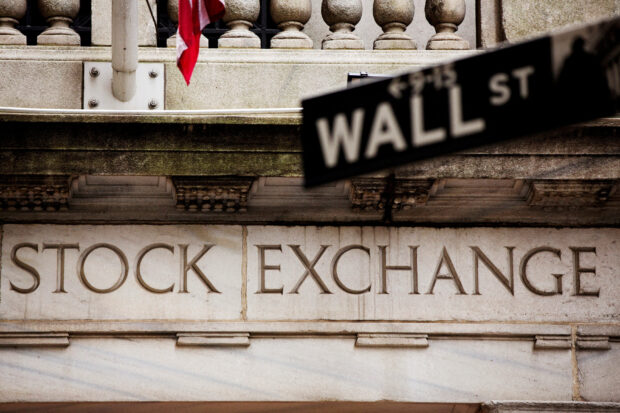
A street sign for Wall Street hangs in front of the New York Stock Exchange May 8, 2013. REUTERS/Lucas Jackson
LONDON – Investment banks and asset managers have wildly varying stock market and currency calls for 2024, reflecting deep division over whether the U.S. economy will enter a long-heralded recession and drag the world with it.
The lack of consensus among forecasters is a stark contrast to a year ago, when most predicted a U.S. recession and rapid rate cuts that failed to materialize. The world’s largest economy expanded by 5.2 percent in the third quarter of this year.
The divisions this year have produced a scattergram of projections for the U.S. interest rate path and how global assets that are influenced by the Federal Reserve’s actions will perform.
Market participants are therefore bracing for a bumpy start to the new year after a strong rally last month for both stocks and bonds based on a short-term consensus that inflation and interest rates are on a firm downward path.
“Whether the U.S. has a hard landing or a soft landing will dominate the market,” said Sonja Laud, chief investment officer at Legal & General Investment Management.
“The narrative isn’t clear yet,” she added, noting that if current interest rate forecasts “were to shift significantly that creates significant volatility”.
Options trading data shows that investors are becoming increasingly interested in protecting their portfolios from heightened stock market volatility ahead.
All together… not
Economists polled by Reuters predict 1.2 percent U.S. GDP growth for 2024 on average.
But while forecasters are united that the Fed’s most aggressive rate hiking cycle in decades will cause a slowdown, they are split on whether 2024 will also include a couple of quarters of economic contraction that may prompt rate cuts and weaken the dollar.
Amundi, Europe’s largest asset manager, now expects a U.S. recession in the first half of 2024, meaning the group is negative on the dollar and likes emerging market assets.
In foreign exchange, Japan’s yen will be the market’s “bright spot” as the Bank of Japan is expected to finally move away from its ultra-easy monetary policy, said Amundi CIO Vincent Mortier.
The yen is trading around 147 per dollar, not too far from 30-year lows.
Morgan Stanley, however, sees no recession and reckons the Fed may keep rates high well into next year. It views the dollar index rising to 111 points from 104 currently, the euro dropping to $1 and the yen recovering only moderately to 142 per dollar.
Stocks, up or down?
For U.S. stocks, which drive world equity markets, forecasters are divided between what Citi head of trading strategy Stuart Kaiser calls the “converts and disciples” of last year’s strong recession consensus.
“Some bears are (still) very dedicated and believe that if it didn’t happen this year it has to happen next year,” Kaiser said.
Deutsche Bank predicts a mild U.S. recession in the first half of 2024 and a whopping 175 basis points of rate cuts, with lower borrowing costs driving the S&P 500 share index to 5,100 points. The S&P 500 has gained 19 percent this year to 4,567.
JP Morgan views a recession as possible and the S&P finishing the year at 4,200, while Goldman Sachs sees only limited recession risk.
Equity analysts’ estimates of S&P 500 earnings are currently the most dispersed since the COVID-19 pandemic, according to Blackrock Investment Institute (BII).
LGIM, which manages roughly $1.5 trillion of assets, is underweight equities and expects a U.S. downturn, Laud said.
Some investors meanwhile had moved beyond the U.S. economy debate to seek other opportunities.
Luca Paolini, chief strategist at Pictet Asset Management, said the firm’s big call was for gains in European equities, which they believed were undervalued.
Bonds are back
Most economic forecasters agree that a global inflation surge is over. But whether this means dramatic rate cuts, which generally raise bond prices as yields fall, is not something investors agree on either.
Bond giant PIMCO puts the probability of a U.S. recession in 2024 at 50 percent and recommends government debt over equities.
HSBC fixed income strategists target a 3- percent yield for the benchmark 10-year U.S. Treasury by late 2024, down from about 4.3 percent currently.
But Adrian Gray, global chief investment officer at Insight Investment Management, said government bond markets had moved too exuberantly already.
“We’re seeing the Fed, the European Central Bank and the Bank of England all cutting (rates) from around Q3 next year,” he said.
“Right now, government bond markets are pricing in more than that,” he said, projecting yields would rise “a little,” from here.

